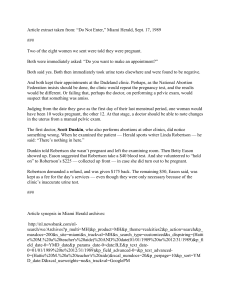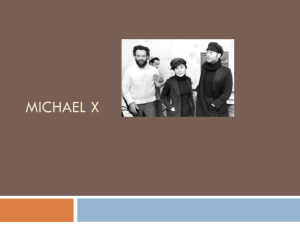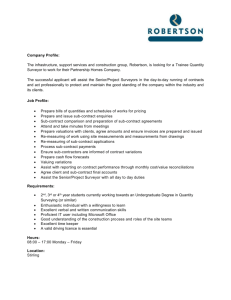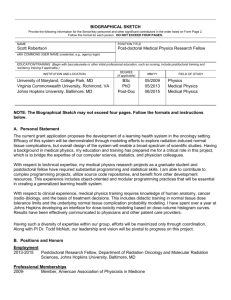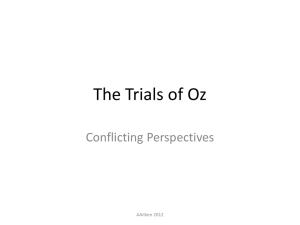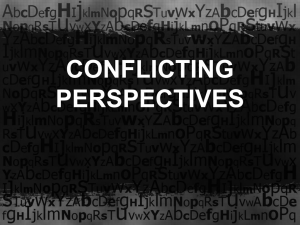Module C: Representation and Text
advertisement
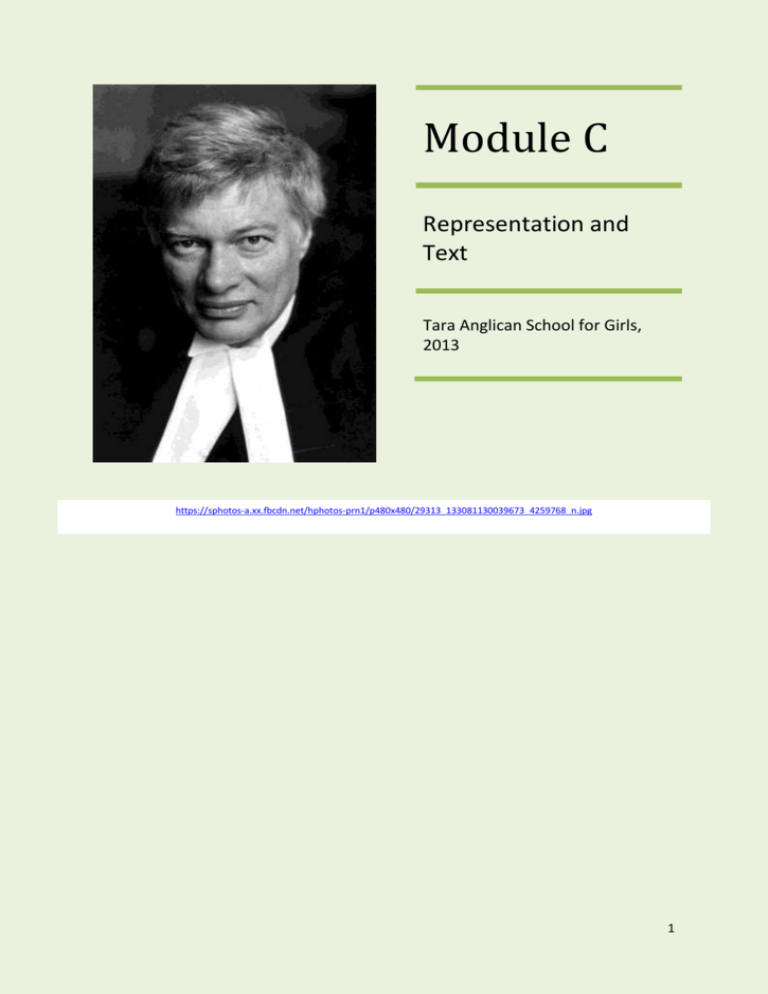
Module C Representation and Text Tara Anglican School for Girls, 2013 https://sphotos-a.xx.fbcdn.net/hphotos-prn1/p480x480/29313_133081130039673_4259768_n.jpg 1 Contents Module C: Representation and Text ....................................................................................................... 3 Rubric ...................................................................................................................................................... 3 Unpacking the Rubric .............................................................................................................................. 4 Prescribed Texts ...................................................................................................................................... 5 HSC Marking Guidelines – Past ............................................................................................................... 5 What is Representation? ........................................................................................................................ 6 Applying Understanding of Representation ........................................................................................... 7 Whose Representation is it, anyway? ..................................................................................................... 8 But, why? ................................................................................................................................................ 8 Geoffrey Robertson................................................................................................................................. 8 Learning Prep Task: ................................................................................................................................. 8 Geoffrey Robertson’s Perspectives ......................................................................................................... 9 Wikipedia: Geoffrey Robertson ........................................................................................................ 10 Education and personal life [edit]................................................................................................. 10 Legal career .................................................................................................................................... 10 Media career ................................................................................................................................... 12 Writing career.................................................................................................................................. 12 Dossier on Robertson............................................................................................................................ 13 Core Concepts ....................................................................................................................................... 14 Positioning ............................................................................................................................................ 14 Subjectivity and Objectivity (Courtesy S. Lack) ..................................................................................... 14 Selective Inclusion of Information ........................................................................................................ 14 Privileging (aka foregrounding)............................................................................................................. 14 Marginalising......................................................................................................................................... 15 Silencing ................................................................................................................................................ 15 Learning Prep – Positioning in the Preface ........................................................................................... 15 Conflicting Perspectives ........................................................................................................................ 15 Conflicting Perspectives – Overview (Courtesy, C.Chapman) ............................................................... 15 Features to Think About, (as you re-read chapters) ............................................................................. 17 Past HSC Questions and Notes from the Marking Centre .................................................................... 18 2 Module C: Representation and Text “The study of how textual forms, choice of language and perspectives represent information, processes and ideas.” p. 15, Stage 6 English Syllabus, Board of Studies, 2010. Rubric This module requires students to explore various representations of events, personalities or situations. They evaluate how medium of production, textual form, perspective and choice of language influence meaning. The study develops students’ understanding of the relationships between representation and meaning. Each elective in this module requires the study of one prescribed text offering a representation of an event, personality or situation. Students are also required to supplement this study with texts of their own choosing which provide a variety of representations of that event, personality or situation. These texts are to be drawn from a variety of sources, in a range of genres and media. Students explore the ways in which different media present information and ideas to understand how various textual forms and their media of production offer different versions and perspectives for a range of audiences and purposes. Students develop a range of imaginative, interpretive and analytical compositions that relate to different forms and media of representation. These compositions may be realised in a variety of forms and media. 3 Unpacking the Rubric Define in your own words, the words and phrases from the rubric. Give an example, where possible. Core Concepts Representations Medium Textual form Influence relationships between representation and meaning Prescribed Text Texts of Own Choosing Supplement Own choosing Which provide a representation of that event, personality or situation 4 Variety of sources in a range of genres and media “how various textual forms and their media of production offer different versions and perspectives for a range of audiences and purposes” Composing A range Imaginative, Interpretative and analytical compositions Prescribed Texts Geoffrey Robertson, The Justice Game * * * * * * * The Trials of Oz Michael X on Death Row “The Romans in Britain” The Prisoner of Venda Show Trials Diana in the Dock: Does Privacy Matter? Afterword: The Justice Game HSC Marking Guidelines – Past In your answer you will be assessed on how well you: demonstrate understanding of and evaluate the relationship between representation and meaning organise, develop and express ideas using language appropriate to audience, purpose and for 5 What is Representation? According to the Board of Studies Syllabus, “representation” refers to “the ways ideas are portrayed through texts.” The following explanation might help you really understand this key term. When an event or situation takes place in time –it: “presents” itself to us. But, after the event or situation, any attempt to explain, analyse, recreate, refer to, relay, and communicate about this event or situation, is, a: Re-presentation Every time an event, personality or situation is re-presented, it is through the: perspective of the composer and their “representation” is only a: version of the event, personality or situation. 6 Applying Understanding of Representation FOCUS QUESTION: Explain how the different forms, mediums, audiences and purposes affect the representations of Justin Bieber, below. 100 words minimum. Representation 1 – Radio Interview “Y’know, I know when I see talent and ah – when I saw JB – I saw talent, man. I mean, uh – I really do think, y’all out there are gonna be part of this phenomenon…He will be, you know, like uh – a male Madonna – a star who stays with his fans through childhood, into adolescence and into adulthood. Haters are gonna be, and that’s a truth. But no doubt, Justin is here to stay.” Representation 2 – Blog OMG I saw Bieber last night and he was sooooo goood! He sang with such heart – his costumes were amazing – it’s true – no one does it like Bieber – he is absolutely one in a million. Bieber 4 eva. . Representation 3 - Feature Article extract Bieber is, like any other boy-man, an unnerving mix of masculinity and childishness. His songs are unashamedly deliberate in their wooing of young fans. At his recent concert, he repeatedly crooned “If I was your boyfriend” setting naïve tween hearts aflame in all their visceral, prepubescent screaming. He is whored out to sing about his heart, sing about love, sing about girls, because, let’s face it; it makes him millions of dollars. Whilst there isn’t anything particularly offensive in his pop beats and repetitive hooks, we would be mistaken if we expected originality from a boy who is simply a product of the music industry’s marketing machine. 7 Whose Representation is it, anyway? To begin understanding how a representation uses its form, features, medium and language to influence the responder, it is important to understand the composer’s: o o o o o o o Background Worldview Ideologies Political beliefs Religious beliefs Attitudes Values But, why? Because it is these beliefs shape the composer, and therefore their representation, their version of events, personalities or situations. Geoffrey Robertson http://epress.anu.edu.au/anzsog/dep_secs/images/ch10photo01.jpg Learning Prep Task: Read, listen and watch the links overleaf and make notes on Robertson’s beliefs and background. A table has been provided for you, but you are encouraged to add fields, extend and modify this to suit your needs. 8 Geoffrey Robertson’s Perspectives From the ABC: http://www.abc.net.au/tv/bigideas/stories/2009/04/17/2545992.htm http://abc.net.au/local/stories/2009/03/30/2529960.htm http://abc.net.au/local/audio/2009/03/30/2530233.htm http://www.abc.net.au/tv/talkingheads/txt/s2523452.htm Transcript from Enough Rope: http://www.abc.net.au/tv/enoughrope/transcripts/s1448925.htm Regarding Julian Assange http://www.abc.net.au/lateline/content/2011/s3354730.htm http://www.abc.net.au/radionational/programs/lawreport/geoffrey-robertson-qcon-assange-case/3927052 Regarding The Justice Game (Useful summaries for each chapter) http://www.abc.net.au/radionational/programs/firstperson/the-justice-game-bygeoffrey-robertson-qc/3250106 International Press Institute Top Media Forum: Geoffrey Robertson http://www.youtube.com/watch?v=5cXkOGQiU9k Listen to following interview segments http://www.boardofstudies.nsw.edu.au/archives/picklestreet/interviews/pgr1.html 9 Wikipedia: Geoffrey Robertson Geoffrey Ronald Robertson QC (born 30 September 1946,) is a human rights lawyer, academic, author and broadcaster. He holds dual Australian and British citizenship. Robertson is the founder and head of Doughty Street Chambers. He serves as a Master of the Bench at the Middle Temple, a recorder, and visiting professor at Queen Mary, University of London.[1][3] Education and personal life [edit] Robertson was born in Sydney, Australia, and grew up in the suburb of Eastwood,[4] attending Epping Boys' High School. He obtained his law degree from the Sydney Law School before winning a Rhodes Scholarship to study at Oxford, where he graduated with a Bachelor of Civil Law.[1][5] In 2006 he was awarded an honorary degree of Doctor of Laws by the University of Sydney.[6] In 1990 Robertson married author Kathy Lette, and they live together in London with their children.[1] They had met in 1988 during the filming of a Hypothetical episode for ABC Television; Robertson was going out with Nigella Lawson at the time and Lette was married to Kim Williams, today CEO of News Limited. In his 2010 Who's Who entry, he lists his hobbies as tennis, opera and fishing. Legal career Robertson became a barrister in 1973. He became a QC in 1988. He became well known after acting as defence counsel in the celebrated English criminal trials of Oz, Gay News, the ABC Trial, The Romans in Britain (the prosecution brought by Mary Whitehouse), Randle & Pottle, the Brighton bombing and Matrix Churchill.[9] He also defended the artist J. S. G. Boggs from a private prosecution brought by the Bank of England regarding his depictions of British currency. In 1989 and 1990, he led the defence team for Canadian artist Rick Gibson and art gallery director Peter Sylveire who were charged with outraging public decency for exhibiting earrings made from human foetuses. He has also acted in well known libel cases, including defending The Guardian against Neil Hamilton MP. Robertson was threatened by 10 terrorists for representing Salman Rushdie.[14]In 1972, he advised Peter Hain as a McKenzie friend when Hain defended himself on several charges including conspiracy to trespass arising from his involvement in anti-apartheid protests, as a protest against the apartheid regime. During the ten-day trial at the Old Bailey Hain dismissed his QC's, but retained Robertson and another as advisers, before being convicted and fined £200. He was also employed to defend John Stonehouse after his unsuccessful attempt at faking his own death in 1974.[9] In 2000, in the Independent Schools Tribunal, sitting at the Royal Courts of Justice, he successfully defended A.S. Neill's Summerhill School, a private free school. The proceedings brought by OFSTED on behalf of then Education Minister David Blunkett who was seeking the closure of the school.[15] The case was later dramatised by Tiger Aspect Productions in a TV series entitled, "Summerhill" and broadcast on BBC Four and CBBC.[16] In August Robertson was retained by heavyweight boxing champion Mike Tyson for a hearing before the British Boxing Board of Control. The disciplinary hearing related to 2 counts relating to Tyson's behaviour after his 38-second victory over Lou Savarese in Glasgow in June that year, Tyson escaped a ban from fighting in Britain.[17] Robertson successfully deployed a defence of freedom of expression for Tyson, the first use before the BBBofC but Tyson was convicted on the other count and fined.Then in 2002, he defended the Dow Jones in Dow Jones & Co. Inc. v Gutnick a case where Joseph Gutnick, an Australian mining magnate, sued the Dow Jones after an article critical of him was published on the website of the Barron's newspaper. Gutnick successfully applied to the Australian High Court, requesting for the case to heard in Australia, rather than the United States, where the First Amendment protects free speech. Robertson then appealed the case to the United Nations Human Rights Committee. The case was described as a "very worrying decision" as it potentially opened the door for libel cases related to internet publishing to be heard in any country and in multiple countries for the same article.[18] In January and December 2002 Robertson was retained by the Washington Post to represent its veteran war correspondent, Jonathan Randal, in the Hague at the United Nations Court, the International Criminal Tribunal for the former Yugoslavia establishing the principle of qualified privilege for the protection of journalists in war crimes courts. In 2006, Geoffrey Robertson, successfully defended the Wall Street Journal (WSJ) in Jameel v Wall Street Journal Europe. The case centred on an article published in the WSJ in 2002, which alleged that the United States were monitoring the bank accounts of a Saudi Arabian businessman to ensure he was not funding terrorists. Jameel, who was represented by Carter Ruck, was originally awarded £40,000 in damages but this was overturned in favour of the WSJ. The case was viewed by The Lawyer as a landmark case which 11 redefined the earlier case of Reynolds v Times Newspapers Ltd, upholding the right to publish if it is deemed to be in the public interest. In early 2007, instructed by aboriginal lawyer Michael Mansell, Robertson took proceedings for the Tasmanian Aborigines to recover 15 sets of their stolen ancestral remains, then residing in the bowels of the Natural History Museum in London. He accused the museum of wishing to retain them for, "genetic prospecting".Robertson has also appeared in cases before the European Court of Human Rights and in other courts across the world. Amongst these, Robertson was involved in the defence of Michael X in Trinidad and has appeared for the defence in a libel case against former Prime Minister Lee Kuan Yew in Singapore. He was also involved in the controversial inquest of Helen Smith and also in the BlomCooper Commission inquiry into the smuggling of guns from Israel through Antigua to Colombia. Robertson has also been on several human rights missions on behalf of Amnesty International, such also to Mozambique, Venda, Czechoslovakia, Malawi, Vietnam and South Africa. Until 2007 he sat as an appeal judge at the UN Special Court for Sierra Leone.[5][23][24] He is a patron of the Media Legal Defence Initiative. As of December 2010, Robertson is defending fellow Australian, WikiLeaks founder Julian Assange in extradition proceedings in the United Kingdom.[5] Media career Since 1981, often with long intervals in between, Robertson has hosted an Australian television series of programmes called Geoffrey Robertson's Hypotheticals.[1] These shows invite notable people, often including former and current political leaders, to discuss contemporary issues by assuming imagined identities in hypothetical situations. He also speaks at public events including many literary festivals. In 2009 he spoke at the Ideas Festival in Brisbane, Australia.[26] Writing career Robertson has written many books.[1] One of them, The Justice Game (1998) is on the school curriculum in New South Wales, Australia.[27] His 2005 book The Tyrannicide Brief: The Story of the Man Who Sent Charles I to the Scaffold details the story of John Cooke, who prosecuted King Charles I of England in the treason trial that led to his execution.[28] After the Restoration, Cooke was convicted of high treason and hanged, drawn and quartered.In his 2006 revision of Crimes Against Humanity, Robertson deals in detail with human rights, crimes against humanity and war crimes. The book starts with the history of human rights and has several case studies such as the case of GeneralAugusto Pinochet of Chile, the Balkans Wars, and the 2003 Iraq War. His views on the United States' atomic bombings of Hiroshima and Nagasaki in Japan can be considered controversial. He considers 12 the Hiroshima bomb was certainly justified, and that the second bomb on Nagasaki was most probably justified but that it might have been better if it was dropped outside a city. His argument is that the bombs, while killing more than 100,000 civilians, were justified because they pushed Emperor Hirohito of Japan to surrender, thus saving the lives of hundreds of thousands of allied forces, as well as Japanese soldiers and civilians.In his 2010 book, The Case of the Pope, Robertson claims that Pope Benedict XVI is guilty of protecting paedophiles because the church swore the victims to secrecy and moved perpetrators in Catholic sex abuse cases to other positions where they had access to children while knowing the perpetrators were likely to reoffend.[29] This, Robertson believes, constitutes the crime of assisting underage sex and when he was still Cardinal Ratzinger, the present pope approved this policy up to November 2002. In Robertson's opinion, the Vatican is not a sovereign state and the pope is not immune to prosecution.[30] Dossier on Robertson Complete as you discover info about this QC! Nationalities Religious beliefs Political beliefs Education Ideologies Causes Spiritual beliefs Family Life Moral make-up Fights for… Believes in… Rallies against… Hates… Dislikes… 13 Core Concepts Positioning Positioning refers to the way a text positions us to accept, reject, believe, adopt its content. For example, the Three Little Pigs positions us to accept that the Wolf is the “bad guy”. But, in the wolf’s version, he positions us to believe that in fact, it was the pigs who had tormented him and that he was only responding to years of piggy harassment. Subjectivity and Objectivity (Courtesy S. Lack) Subjective taking place within the mind and modified by individual bias; "a subjective judgment" subjectivity (noun) = judgment based on individual personal impressions and feelings and opinions rather than external facts wordnet.princeton.edu/perl/webwn subjectively (adverb) = in a subjective waywordnet.princeton.edu/perl/webwn influenced by personal feeling, opinion or bias peninsula.swiftclassroom.com/kms/molson/documents/scientific_process_vocab.doc Objective undistorted by emotion or personal bias; based on observable phenomena; "an objective appraisal"; "objective evidence" serving as or indicating the object of a verb or of certain prepositions and used for certain other purposes; "objective case"; "accusative endings" aim: the goal intended to be attained (and which is believed to be attainable); "the sole object of her trip was to see her children" emphasizing or expressing things as perceived without distortion of personal feelings, insertion of fictional matter, or interpretation; "objective art" Selective Inclusion of Information The phrase “selective inclusion” refers to the understanding that any composer can select the evidence, anecdotes and information they include in their composition and exclude anything they want to, to support and put further their representation, their version. Privileging (aka foregrounding) When a particular voice or perspective is given preference, we refer to it in literary studies as “privileging” because that viewpoint has been given the privilege to be heard as a priority. Another term for this is “foregrounding”, again, making reference to bringing one perspective to the “fore” – that is, the front. 14 Marginalising When a “voice” or peoples are marginalised, it means they have been (or their “voice” has been) pushed to the fringe, the outer peripheries, the margin of the text, so that their voice is minimised. Look at the margin in your workbook, and this term will become clearer for you! Those notes in the margin are those that are on the side, pushed aside, treated as secondary. Silencing Silencing refers to voices or peoples who are not heard in the text at all. For example, for many years in Australian history, the Indigenous experience was completely silenced from History textbooks. Learning Prep – Positioning in the Preface Now that you understand the term “positioning”, explain, using reference to specific extracts and features, how the Preface positions you as a reader. How are you positioned to perceive Geoffrey Robertson? Explain in 150 words. Conflicting Perspectives What do you think the term “conflicting perspectives” means? Jot your ideas here! Then, confer with a friend. Conflicting Perspectives – Overview (Courtesy, C.Chapman) How are conflicting perspectives in the text represented? Robertson explores conflicting perspectives through the adversarial system of the Law. Although this is a good way of examining the truth, even the Law can be manipulated. Thus JUSTICE is the search for truth in perspectives … or should be. Robertson shows that one perspective can be represented in a particular way, depending on the power of the era. In referring to the show trials in the Soviet Union he observes “Stalin’s show trials still haunt because they prove how legal systems, with the varying procedural rituals for emphasising objectivity and impartiality – and apparent ability to extract the truth – can be vulnerable to political manipulation.’ The story of the execution of Michael X and the haste in which people were executed is also a reminder of the fact that a strong perspective, which accepts no defiance, is the preserve of the powerful. 15 Note that Robertson positions the reader by giving his own opinion on characters, rather than the facts for the reader to judge. Even his analysis of judges is biased to give a specific impression and make a point. These opinions may or may not be true, but they leave little room for another perspective. Also, Robertson never really discusses the guilt of his clients and certainly never questions it. They are all cases which need his ‘help’ and he maintains he is the one to answer the call. For instance, Michael X is guilty of murder and was a criminal in England. Robertson seems to go to extraordinary lengths to save the life of the guilty – is it too cynical to suggest it was a high profile case for Robertson!! Diana in the Dock certainly was high profile. Note that Robertson is prepared to test the privacy laws, but is also an anti-monarchist and deeply cynical of Diana. He uses the chapter to mock her and the Royal Family. Not only does he state ‘she wanted privacy only when it suited her’, he is even harsher in his observation that she ‘was taking a leaf out of the Benetton advertising book, using the diseased and dying as visual props to make herself look better than she was.’ Robertson positions himself as a seeker of truths and fighter of injustice. Even when he loses, he was right and they were wrong. Keep this in mind when analysing how he represents other perspectives. 16 Features to Think About, (as you re-read chapters) Robertson’s use of language is important – this is how he presents his own perspective – and gives perspectives on others. Remember, always think: Whose views are we hearing What is his context? Who is marginalised? Who is silenced? How are we positioned? VOCABULARY: Robertson’s language is articulate and he makes frequent use of legal terms. The Glossaries will translate these for you – but WHY does he do it? Why doesn’t he simplify for a mainstream audience? TONE: Robertson moves from crusading (Michael X) to cynical (Diana), depending on how he views the character being discussed. See also Positioning. POSITIONING: He is keen to position the reader to dislike those who are against him, particularly judges in England and overseas. He dismisses Judge Argyle’s position as being ‘a career consolation for the Tory MP he had several times tried to become …’ At times he sees his clients in the same way. He calls Michael X a ‘token black’, says his approach was ‘derivative’ – even though he does say MX was a changed man. Self-importance by Association. Robertson often positions himself as important through his association with other important figures and dignitaries, such as Vaclav Havel etc. IMAGERY: Robertson uses theatrical imagery and allusion. References to The Mikado, his love of theatre, his own play writing etc. This lends itself also to the idea of performance in the arena of the Court. EMOTIVE LANGUAGE. In Michael X Robertson uses emotive language to show his outrage at the treatment of prisoners and the death penalty in general. “There were 30 men, sweating in the heat, fingers scratching through the wire of the concrete-floored cages, screeching and shouting at each other and the warders” (P76). Whilst this conveys the horror that Robertson wants to convey, there is no mention of what crimes the prisoners may have committed – or the victims. 17 Past HSC Questions and Notes from the Marking Centre Year 2012 Question Analyse how the representation of divergent viewpoints leads us to a greater awareness of the complexity of human attitudes and behaviour. In your response, make detailed reference to your prescribed text and at least ONE other related text of your own choosing. 2011 Explore how The Justice Game and ONE other related text of your own choosing represent conflicting perspectives in unique and evocative ways. Notes from Marking Centre Better responses explored the author’s positioning of the responder and the consequent impact this has on the development of their personal insight into the complexity of human attitudes and behaviour. In some responses, candidates explored divergent viewpoints between characters, while others focused on internalised divergence and the impact this has on eventual understanding about humanity’s complexities. In stronger responses, candidates were conceptual and analytical. They demonstrated perceptive understanding of the requirements of the module, elective and question, and presented wellchosen textual references from all of their selected texts. In weaker responses, candidates superficially referred to conflicting perspectives, and this was sometimes limited just to conflict. They were descriptive and did not demonstrate an understanding of the module. Justice Game In better responses, candidates addressed themselves skilfully to the question, supporting their thesis with an extensive range of textual details to explore how representation enabled a greater awareness of the complexity of human attitudes and behaviours. In these responses, candidates analysed and evaluated the ways in which composers represented divergent viewpoints in order to shape meaning and how a greater awareness had been gained through these representations. Stronger responses demonstrated a perceptive understanding of how composers use different ways to construct meaning and evoke responses through textual features and details. These responses presented a cohesive, focused and incisive thesis that dealt confidently and directly with the demands of the question. The analysis and evaluation of the textual evidence from the prescribed text – and text of own choosing – were used skilfully to consider how the unique act of representation in both texts evoked responses. The exploration of how the text’s form, medium of production, language features and purpose shape meaning was seamlessly integrated and used to further the thesis. Masterful control of language was evident as these responses developed the thesis through strategic-topic sentences, a confident and informed approach to both texts and clear consideration of the key ideas. It was evident that the selection of the text of own choosing – and how it was used to respond to the question and connect with the prescribed text – influenced the quality of the response. Weaker responses focused more on an exploration of the prescribed text and text of own choosing through the elective rather than the focus of the module – the act of representation. The responses were largely descriptive and limited in scope, and the exploration of the unique ways of representing history and memory or conflicting perspectives was superficial or largely ignored. Some of these responses did present a simple line of argument, but it was not developed further through relevant textual references. Generally, the text of own choosing was inappropriate and not used to further the response to the question. 18 2010 To what extent has textual form shaped your understanding of conflicting perspectives? In your response, make detailed reference to your prescribed text and at least ONE other related text of your own choosing. Conflicting Perspectives Many candidates developed responses that examined conflicting perspectives within the world of a text and/or across the prescribed text and the text or texts of own choosing. In stronger responses, candidates integrated their evaluation of how the conflicting perspectives were represented by the form of the prescribed text and texts of own choosing through a perceptive exploration of an event, situation or personality. Weaker responses focused on conflicting perspectives rather than on evaluating how these perspectives were represented by the composer through the form and its textual features. They described the conflict between individuals within a text rather than consider the ways that conflicting perspectives on an event, situation or personality were represented. 19
